
How Jazz Guitar Licks Can Keep You Out of Trouble
Jan 18, 2018A Gentle Introduction to Learning Licks for Jazz Guitarists
Jazz guitar licks can keep you out of trouble? If you are like most musicians, there might be a trouble spot in your playing or performance areas that could use a little work. Learning a few jazz guitar licks just might help to keep you out of trouble in your playing and even provide a creative base to build on. There are a few basic things to learn first.
Join our Community here.
Learn their “architecture” if you want to get good with them. It’s best to really know a few licks rather than just memorizing lots of them. When you really hear a lick and get the feel of it, you can start to build on it and are free to create countless variations on that one lick.
The jazz guitar licks on this page are common public domain phrases that are part of most experienced jazz players’ trick bag. Even better to know is that lots of jazz vocabulary is often just ornamentations of these basic jazz guitar licks and ideas.
Outstanding players create the best-improvised solos based on only a handful of ideas. That applies even to John Coltrane!
The jazz solo is like a story. It has to go somewhere and be developed. Likewise, that one solo is way more important than just putting together lots of different jazz guitar licks. That would be like an author putting random sentences into a story.
Every great jazz story goes somewhere and this one might just keep you out of trouble.
Table of Contents
-
- Blues Licks
- Major
- Minor
- Relative Minor Concept
- Building Blocks for Jazz Guitar Licks
- Short II-V’s
- Long II-V’s
- Plug-ins
- Octave Displacement
- Outlining Chord Changes
- Classic II-V Licks
- Minor II-V Licks
- Blues Licks
Jazz Guitar Licks: Major Blues
The most obvious jazz guitar licks come from the blues scales. The blues has permeated jazz improvisation since the very beginning of jazz.
All aspiring jazz guitarists have to learn at least some blues!
Blues licks constructed from the blues scales are simply pentatonic scales with an added tone. The extra note (aka the blue note) creates the blues “feel” or sound for these licks.
The major blues scale consists of the major pentatonic (1 2 3 5 6) with the added b3.
Here’s the C major blues scale along with a few nice licks.
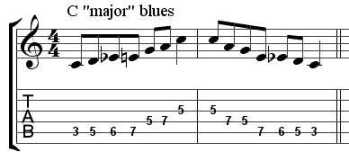
“Major” Blues Licks:

This C major blues concept is often played in the first four bars of the blues in the key of C. Note the presence of both major AND minor thirds.
See some very common blues progressions on this page here.
Jazz Guitar Licks: Blues in a Minor Scale
The minor blues scale consists of the minor pentatonic (1 b3 4 5 b7) with the added b5 (also a #4).
Here’s the C minor blues scale and a few cool licks:
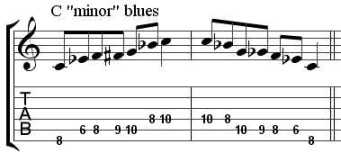
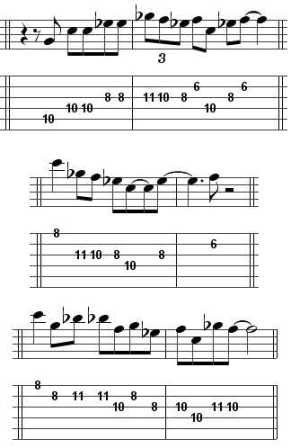
This C “minor blues” scale is often used to improvise in the fifth bar of the blues in the key of C. The minor third and the “blue note” give the scale it’s “down to earth” feel.
Relative Minor Concept
It’s important to note that the “relative minor” concept also applies to blues scales. This means that jazz guitar licks that work in C “major blues” will also fit in the A “minor blues” scale. In fact, alternating between the major and minor blues scale is a very common thing to do for jazzers.
Here’s the “Beginning Blues Improvisation” video to help you do just that:
Furthermore, bluesy jazz guitar licks applied on non-blues tunes such as standard and rhythm changes sound fantastic. Experienced jazz players can and will play blues lines anywhere. In fact, my personal favorite players are bluesy most of the time! For instance, check out the way Metheny and Scofield improvise very bluesy lines on non-blues songs. Try it yourself, and blues-up your jazz guitar playing.
Building Blocks for Jazz Guitar Licks
Short II-V Jazz Guitar Licks (in One Bar)
The II-V progression with chords that lasted only two beats (a short II-V) was something mostly played by jazzers in the bebop movement of the 40’s and 50’s. It forces the player to be specific, clear and concise in his ideas. You have no time to think when chords last only two beats, especially at faster tempos!
The most important aspect of any of these licks is the resolution of the b7th in the II chord to the 3rd of the V chord. It defines the chord change clearly and happens, for example, when playing the notes C to B when going from chords Dm7 to G7.
The other important resolution is the final note. The examples below resolve to the 3rd or 5th of the I chord (root).
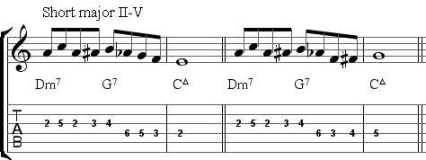
Transpose the last part of the above licks (G7 to CM) up an octave and you get the following:
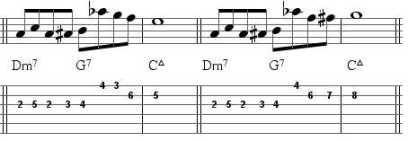
This process is called octave displacement or “spinning”. It would also be possible, and advisable, to take the entire lick up an octave. Many versions of the same lick are ideal for increasing potential development of your ideas.
Easy “Plug in” Lick Parts (some assembly required!)
Here’s a Dm7 idea that gets us to the necessary resolution of the notes C to B.
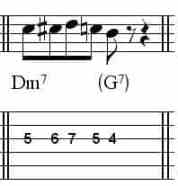
Take it and “plug it” in to the other G7 ideas above. Creativity and a few notes will get you far. Grab your toolkit and give it a go.
Here is a G7 chord with a b9 idea landing in comfortable resolution exactly on the I chord.
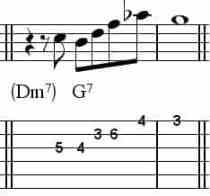
Patience and dedication to learning some basic foundational jazz guitar licks will reveal a wealth of musical treasures beyond the two short Dm7 licks and the three short G7 licks we discussed above.
There are even more building blocks for jazz vocabulary revealed below. Explore! Our trouble free jazz story continues.
Long II-V Jazz Guitar Licks (in two bars)
The long II-V is a progression with chords that last two bars each and is also part of the bebop movement.
Jazzers have harmonized standard tunes with lots and lots of those “long II-V’s”.
There is much more flexibility and room for different ideas in the two-bar progression, right up to the resolution of the 7th.
In general, these II-V’s contain more scale runs (or scale fragments) than their shorter cousins. They also have more chromaticism and “outside” notes.
See all the notes of the C major scale plus a chromatic passing tone below:

Here’s the same lick transposed an octave higher:

Here is another typical bop lick for you:

This one contains octave displacement.

Work with all these jazz guitar licks and make them your own. Find the foundational notes of licks and build them from scratch. Longer II-V phrases are very flexible. Only the “core” of the lick matters, so you can add ornaments in many musical ways.
Outlining Chord Changes
Here are a few of my favorite jazz guitar licks. What I like most about them is how they outline the harmony clearly. Study them carefully and they’ll find a way into your playing.
Don’t forget to practice your licks in all keys, through chord cycles!)
Classic II-V Jazz Guitar Licks
This first lick is a classic shown in different keys and covers other string sets. Move this one around and add the b9 to the V chord. You may have to change the fingerings if you add the b9.
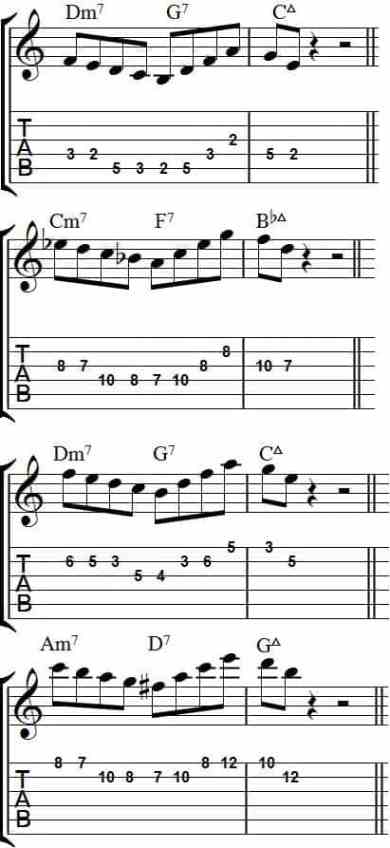
This next lick is very similar to the previous one except the triplet figure and the ending are different. Play this one in a few different keys to demonstrate possible string transference. See the note below about using different string sets.
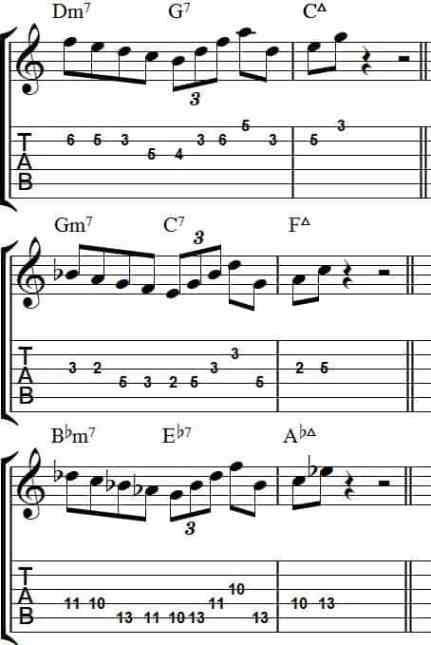
A Note about Different String Sets
Play the above two jazz guitar licks on several different string sets. It is basically the same lick but on different strings.
Play the following licks in different keys to see how you can finger them on different string sets. It’s useful, and if you really want to stay out of musical trouble, it’s necessary.
More Jazz Guitar Licks
The following licks are from actual jazz recordings and explained in the Outline No.1 in major, from the book, Connecting Chords with Linear Harmony (by Bert Ligon).
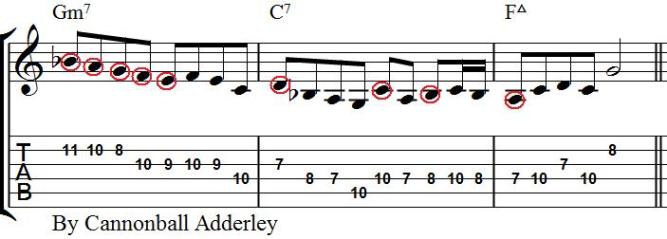
Notice how the circled notes form a descending version of F major scale (starting on Bb).
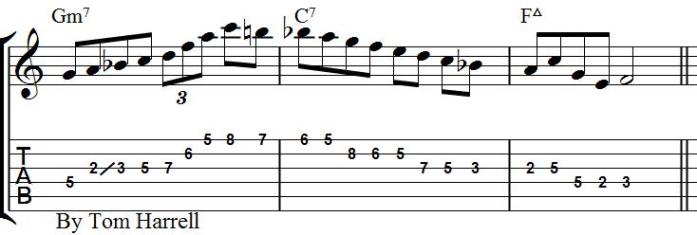
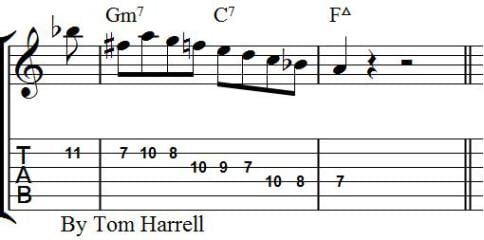
Can you identify what bebop piece this next one comes from?
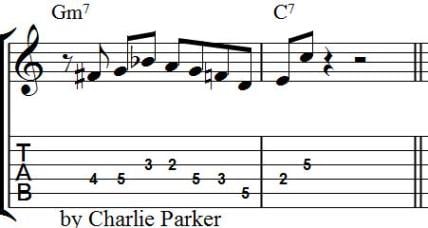
That’s right: Scrapple from the Apple is the tune in question.
Soloing on the Minor II-V – aka Minor 251 Licks
Here are a few of my favorite jazz guitar licks to play in minor. What I like the most about them is they are clearly outlining the harmony. Study them carefully and they’ll find a way into your playing. If you are struggling with improvising on such progressions as Dm7 (b5) to G7 (b9) to C minor, you’ll find these licks very helpful!
Minor II-V Jazz Guitar Licks
This first jazz lick is simply the descending harmonic minor scale starting on the fourth degree, which is also the third of the II chord. Notice how it outlines the chord changes.
We have the 3rd of each chord played on strong beats, and that’s how it works. It's written in different keys below to cover other string sets.
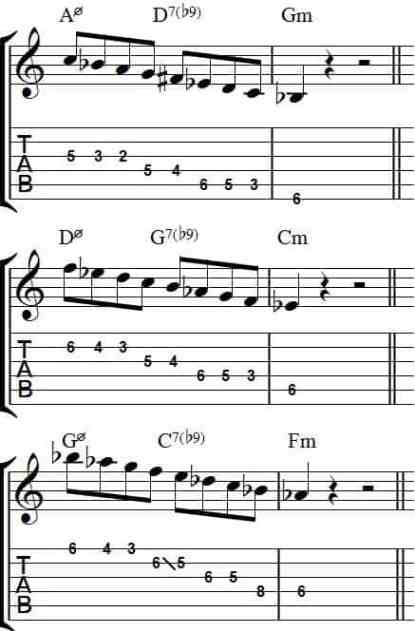
This next jazz lick is very similar to the previous one; but instead of running the scale, it runs arpeggios. You will notice they are also in a few different keys to demonstrate possible string transference.
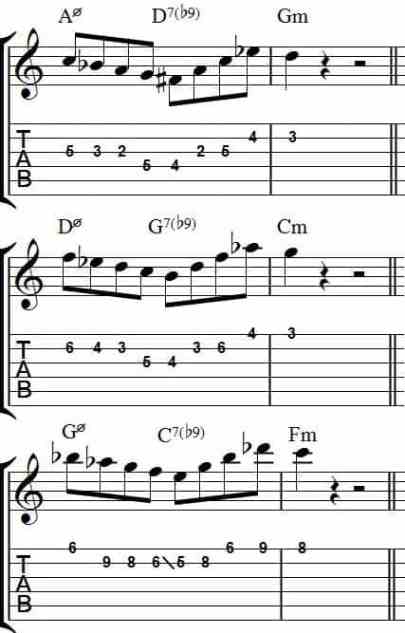
Play licks in different keys to see how you can finger them on different string sets. This is a great idea to incorporate into your regular practicing.
Did you notice the above jazz licks are making use of the harmonic minor scale of the destination chord? So, when playing Dm7b5-G7b9 to Cm, use the C harmonic minor scale exclusively, sometimes called HMD (harmonic minor of destination).
Note:
There are other solutions to minor 251 licks, including the use of the melodic minor scale. I recommend you a practical guide for the minor II-V-I.
More Minor II-V (251) Jazz Guitar Licks
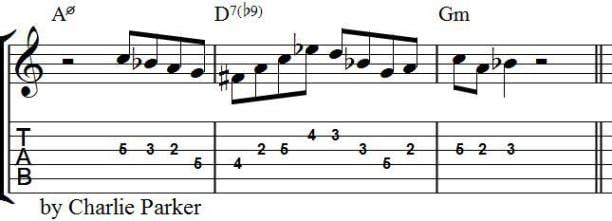
Notice how the previous line is only a slight development of the one before.
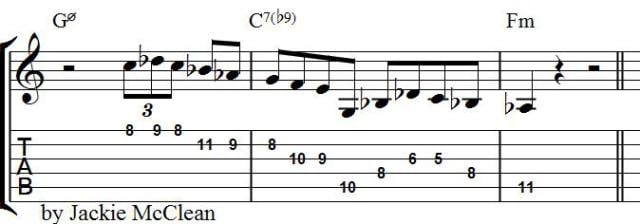
Notice the octave displacement on the C7.
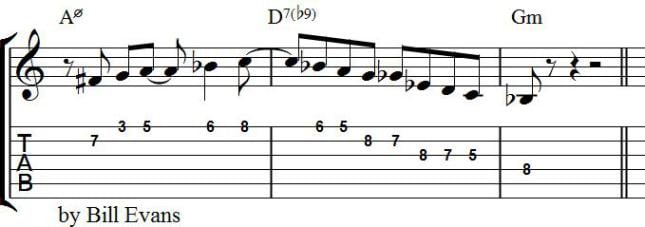
That is some interesting rhythms in the first bar.

The master of “cool” jazz lays down that beautiful lick.
I like the ending very much, it’s a classic.
Conclusion
With all these jazz guitar licks and know-how added to your gig bag, you are well on your way to staying out of trouble, but here is even more great information for inspirational ideas on the ll-V progression:
Play through Connecting Chords with Linear Harmony by Bert Ligon. Tons of great stuff!
Join our Community here.









